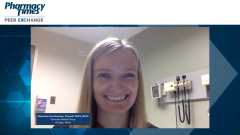
The Goals of Guideline-Directed Medical Therapy in HF
Panelists consider the goals of guideline-directed medical therapy and reflect on how recent updates to clinical practice guidelines may impact therapeutic pathways.
Episodes in this series

Richard Mullvain, RPh, BCCP, BCPS, CCCC: Let’s move on now. This is circling back to the guidelines we’ve been talking about. I want to make sure pharmacists understand the goals of guideline-directed medical therapy, or GDMT. We’ve already commented briefly on the 2021 update to the ACC [American College of Cardiology] Expert Consensus Decision Pathway for Optimization of Heart Failure Treatment. The previous update was 4 years prior, in 2017. I’m curious to get your takes on what has been or will be the impact on clinical practice. I’m going to start with you, Ryan. If you can, comment on the recent update in the guidelines and how you see this impacting practice, including the shout-out of pharmacy involvement.
Ryan Jacobsen, PharmD, BCPS: First of all, the goals of guideline-directed medical therapy are 3-fold. One is to improve patient symptomatology. The second is to prevent hospital admissions. The third is to reduce mortality. As we’ve outlined throughout this program, we have high quality evidence for backbone therapy. Alex referred to it as quadruple therapy. Optimal management of heart failure involves a provision of clinical care with evidence-based, guideline-directed medical therapy in a patient-centered manner that involves shared decision-making by an interprofessional team of health care professionals across the continuum of care, all the way from hospitalization—if we have patients being admitted—to the outpatient heart failure management team and primary care, and then our community pharmacists as well.
The 2021 update was released in early 2021. It provides updated guidance and recommendations on how to streamline clinical care so we can achieve optimal outcomes for patients with heart failure and reduced ejection fraction. There are 10 pivotal issues that are touched upon. The exciting thing is that out of those 10, pharmacists impact at least 8 or 9 of them. It ranges from how to implement guideline-directed medical therapy; when to initiate, add, or switch; how to titrate; how to address challenges with care coordination; the value and essential skills for a heart failure team; and how to address adherence. Approximately 20% to 50% of patients with heart failure are considered to have poor adherence. This is a big opportunity. We’re going to talk a little about that in a minute. There are a few other issues related to medical therapy, including cost and comorbid management.
The ACC Expert Consensus Decision Pathway provides a really nice treatment algorithm for how to progress through getting patients started on and titrated with these agents. An important point Alex mentioned is that, in some other disease state management, we’ll typically start a patient on a medication, titrate them to the maximum dose before you add another drug, titrate that to a maximum dose, and then add another drug to try to avoid polypharmacy. Sometimes, we’ll use lower doses to better care for patients. But specifically, in this treatment algorithm, it’s important that we try to get patients initiated early on these guideline-directed medical therapies. Those are β-blockers; RAS inhibition with either ACE [angiotensin converting enzyme], ARB [angiotensin receptor blocker], or ARNI [angiotensin receptor neprilysin inhibitor]; an aldosterone antagonist like spironolactone; and now with the latest evidence, SGLT2 [sodium-glucose cotransporter-2] inhibitors. Once we do that, we want to titrate those patients aggressively.
This decision pathway has a major emphasis on team-based care and strong support for pharmacists. It’s mentioned throughout. In fact, I had to remind myself this wasn’t a publication in a pharmacist journal. It’s a major publication by the American Heart Association and the American College of Cardiology. This is because guideline-directed medical therapy improves clinical outcomes. It involves frequent dose adjustments and monitoring, so we can achieve those target or maximally tolerated doses. Pharmacists play a very important role, and that includes everyone on the pharmacist team. We talk a lot about the medical team, the subspecialists, and the primary care doctor. I view these patients with heart failure as having a pharmacist team. That includes the heart failure team pharmacist, like Alex; the inpatient pharmacist, both before and after hospitalizations; and then the community pharmacist. Every pharmacist across the continuum of care is vital to successful outcomes with these patients.
Richard Mullvain, RPh, BCCP, BCPS, CCCC: That’s great, Ryan. Thank you very much. The guidelines are very bold. They gave us direction to titrate β-blockers and ACE inhibitors every 2 weeks, which is way more aggressive than I had ever seen. One of the tidbits was to initiate a β-blocker when a patient is dry, but use an ACE or ARB when the patient is wet. They’re starting to drill down and give us a little more guidance on things like that.
Transcript edited for clarity.
Newsletter
Stay informed on drug updates, treatment guidelines, and pharmacy practice trends—subscribe to Pharmacy Times for weekly clinical insights.








